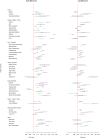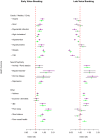Puberty timing associated with diabetes, cardiovascular disease and also diverse health outcomes in men and women: the UK Biobank study
- PMID: 26084728
- PMCID: PMC4471670
- DOI: 10.1038/srep11208
Puberty timing associated with diabetes, cardiovascular disease and also diverse health outcomes in men and women: the UK Biobank study
Abstract
Early puberty timing is associated with higher risks for type 2 diabetes (T2D) and cardiovascular disease in women and therefore represents a potential target for early preventive interventions. We characterised the range of diseases and other adverse health outcomes associated with early or late puberty timing in men and women in the very large UK Biobank study. Recalled puberty timing and past/current diseases were self-reported by questionnaire. We limited analyses to individuals of White ethnicity (250,037 women; 197,714 men) and to disease outcomes with at least 500 cases (~ 0.2% prevalence) and we applied stringent correction for multiple testing (corrected threshold P < 7.48 × 10(-5)). In models adjusted for socioeconomic position and adiposity/body composition variables, both in women and men separately, earlier puberty timing was associated with higher risks for angina, hypertension and T2D. Furthermore, compared to the median/average group, earlier or later puberty timing in women or men was associated with higher risks for 48 adverse outcomes, across a range of cancers, cardio-metabolic, gynaecological/obstetric, gastrointestinal, musculoskeletal, and neuro-cognitive categories. Notably, both early and late menarche were associated with higher risks for early natural menopause in women. Puberty timing in both men and women appears to have a profound impact on later health.
Figures




Comment in
-
Puberty timing has profound effect on later health, study finds.BMJ. 2015 Jun 18;350:h3318. doi: 10.1136/bmj.h3318. BMJ. 2015. PMID: 26092870 No abstract available.
References
-
- Sorensen K. et al. Recent secular trends in pubertal timing: implications for evaluation and diagnosis of precocious puberty. Hormone research in paediatrics 77, 137–145, doi:10.1159/000336325 (2012). - PubMed
-
- Harrington J. & Palmert M. R. Clinical review: Distinguishing constitutional delay of growth and puberty from isolated hypogonadotropic hypogonadism: critical appraisal of available diagnostic tests. The Journal of clinical endocrinology and metabolism 97, 3056–3067, doi:10.1210/jc.2012-1598 (2012). - PubMed
-
- Parent A. S. et al. The timing of normal puberty and the age limits of sexual precocity: variations around the world, secular trends, and changes after migration. Endocr Rev 24, 668–693 (2003). - PubMed
-
- Prentice P. & Viner R. M. Pubertal timing and adult obesity and cardiometabolic risk in women and men: a systematic review and meta-analysis. International journal of obesity 37, 1036–1043, doi:10.1038/ijo.2012.177 (2013). - PubMed
Publication types
MeSH terms
Grants and funding
LinkOut - more resources
Full Text Sources
Other Literature Sources
Medical
Miscellaneous

